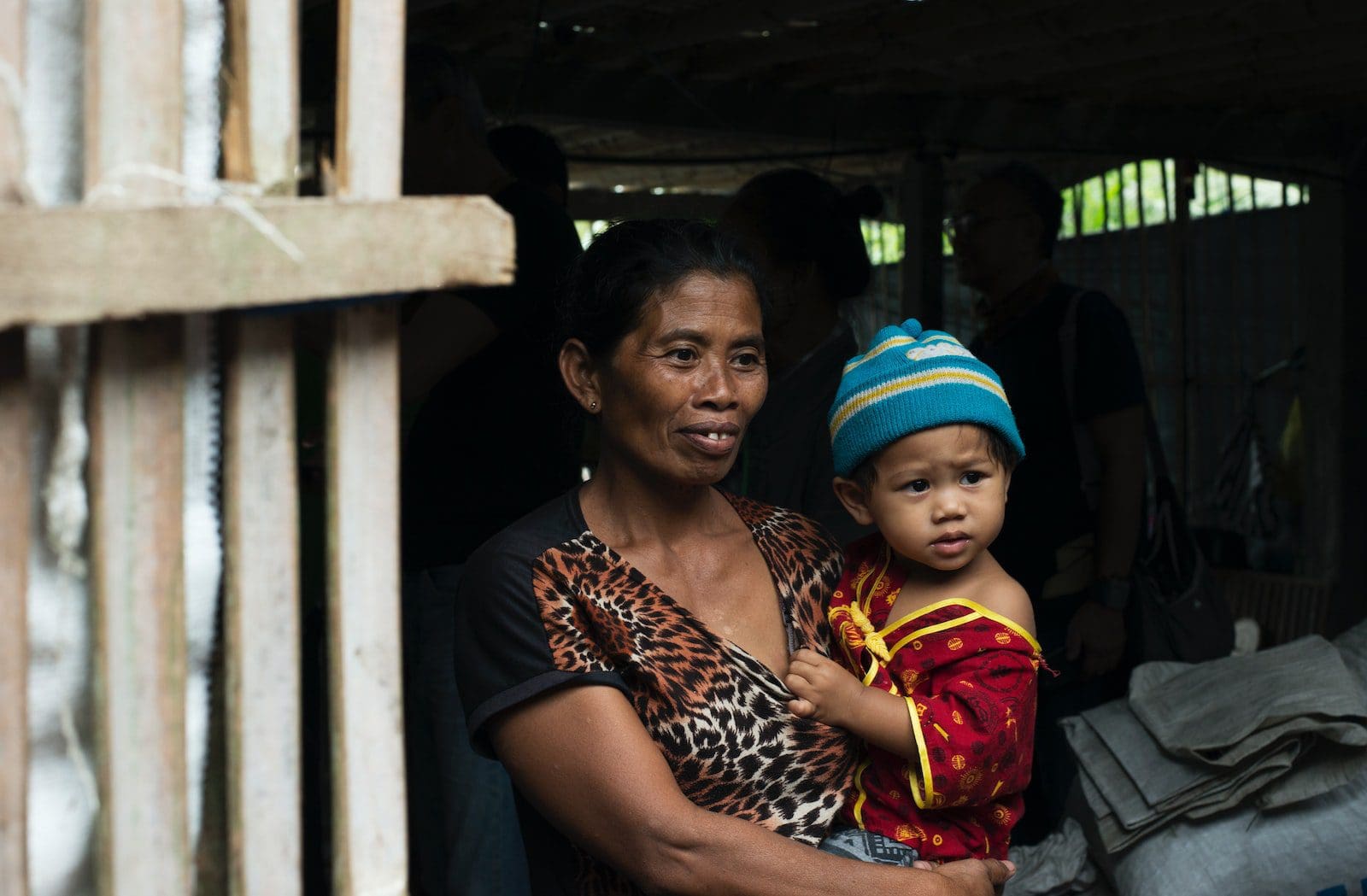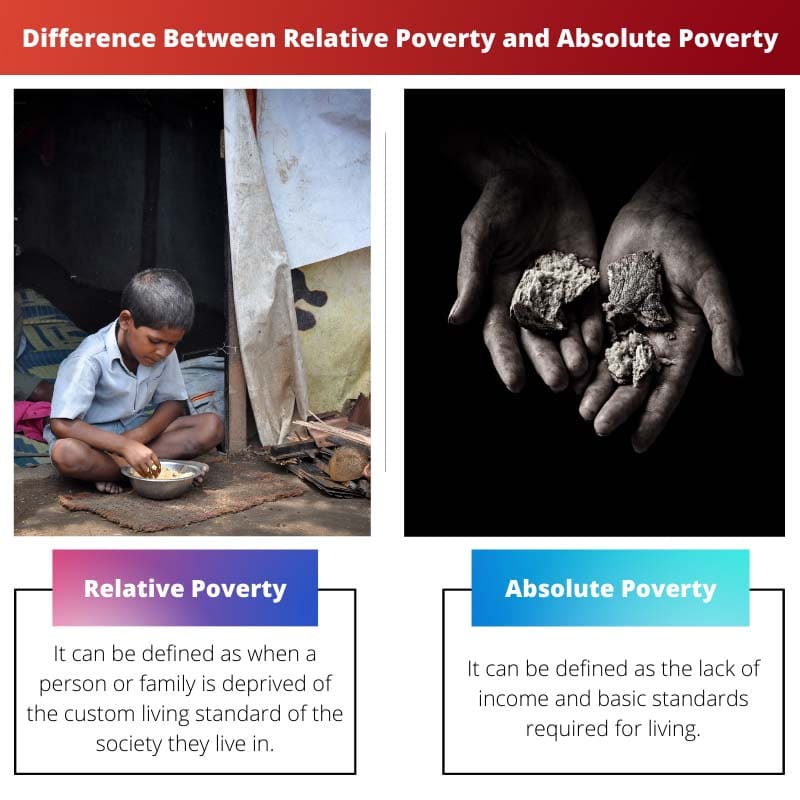India is a developing country, and many families and individuals come under the poverty line. The poverty line criteria are made to measure the number of individuals and families between other countries.
And to do so, the two said terms are introduced – Relative Poverty and Absolute Poverty.
Key Takeaways
- Relative poverty refers to the condition where people have lower economic status than the majority of the population in their society.
- Absolute poverty refers to the condition where people do not have access to the necessities of life, such as food, shelter, and healthcare.
- Relative poverty is relative to the society in which one lives, while absolute poverty is an objective measure of deprivation.
Relative Poverty vs Absolute Poverty
The difference between Relative Poverty and Absolute Poverty is that Relative Poverty can be stated when a family is destitute of the usual living standards decided by the society they live in, while Absolute Poverty is when there is a situation in a family or a person lack proper income and proper basic standards of living.

Relative Poverty depends on the economy of a country. It measures the number of people who are financially less stable but can afford a bare living and a person or family who is financially unstable and cannot afford a basic living. It is said to be that it can never be eradicated.
Absolute Poverty is measured based on a person or a family who cannot afford basic living standards such as – food, housing, clothing, etc. This measuring standard helps in making a comparison between different countries. Also, it is said that Absolute Poverty can be obliterated.
Comparison Table
| Parameters of Comparison | Relative Poverty | Absolute Poverty |
|---|---|---|
| Definition | It can be defined as when a person or family is deprived of the custom living standard of their society. | It can be defined as the lack of income and basic standards required for living. |
| Concept | Prof. Peter Townsend conceptualized it. | It is traditionally accepted. |
| Cause | The leading cause of relative poverty is the difference in income. | The cause of absolute poverty is the low PCC, low PCI, lack of income, etc. |
| Nature | Relative Property is said to be universal and is present in every country. | Absolute Poverty is not universal and also not necessary to be present in every country. |
| Method of Mitigation | Relative Poverty can be reduced if the income gap between rich and poor diminishes. | Absolute Poverty can be reduced if there is a reduction in population, an increase in income, an employment increment, etc. |
| Results | It results in inequality. | It results in mass poverty. |
| Reference to Poverty Line | The people coming under Relative Poverty lives above, below, or on the poverty line. | The people coming under Absolute Poverty lives under the poverty line. |
What is Relative Poverty?
Relative Property is well-defined as the condition where a person and a family lack the minimum amount to live the basic standard of living in society. Compared to absolute poverty, it is not that extreme. Professor Peter Townsend gave the idea of Relative Poverty.
The main reason behind the increase in Relative Poverty is the income gap between the rich and poor.
Relative Poverty is stated to be universal and is used as a measure to compare other countries, which means it is present in every country. The people falling under the criteria are said to be slightly above, on, or below the poverty line.
There must be a reduction in the gap in income between the rich and poor people to reduce the effect of Relative Poverty because nowadays, richer are getting richer and poorer are bringing in more worst conditions.
As it is an indicator for measurement, it is used as the economic status of the people—relative Poverty changes with the economy of the country.
The standard of Relative Poverty varies from place to place. And the people living in Relative Poverty are said to be in the middle class but still cannot meet the basic livelihood custom things; therefore are said to be in the lower middle class.

What is Absolute Poverty?
Absolute Poverty is associated with individuals and families living under the poverty line. Absolute Poverty depends on the two criteria given below:
- Minimum Calories Consumption Criteria – It is stated that when a person in rural areas cannot consume 2400 calories per day and 2100 calories per day in urban areas, it is called the criteria for minimum consumption of calories.
- Minimum Consumption Expenditure Criteria – It is stated as the average amount of expenses a person can do per day. The minimum amount for it is fixed by the government separately for rural and urban areas. Also, the amount set for the criteria is flexible annually or biannually depending on inflation and other factors.
The concept of Absolute Poverty is accepted worldwide. And some of the cause of Absolute Poverty is the low Price-Consumption Curve (PCC), low Per Capita Income (PCI), lack of income, etc.
It is believed that, unlike Relative Poverty, Absolute Poverty is not a universal term and is unnecessary in every other country. It can also be reduced by controlling the population count and increasing the number of employed people, ultimately increasing income.

Main Differences Between Relative Poverty and Absolute Poverty
- Relative Poverty can be described as when a person or family cannot cope with the norms of society. At the same time, Absolute Poverty is the shortage of basic living standards for a person or a family.
- Professor Peter Townsend gave the concept of Relative Poverty, while Absolute Poverty was already traditionally accepted.
- The difference in income is the primary cause of Relative Poverty, while the shortage of revenue, PCC, PCI, etc., is the cause of Absolute Poverty.
- The nature of Relative Poverty is universal and is accepted by every country. In contrast, Absolute Poverty is not a universal thing and is not a necessary thing to be taken by every government.
- Relative Poverty is said to result in higher inequality among others. In contrast, Absolute Poverty results in mass poverty (it will only happen when about 50% or more population comes under the poverty line).
- Regarding the poverty line, people under Relative Property live above, below, or on the line of poverty, while in the case of Absolute Poverty, they live below the poverty line.
- The difference can reduce relative Poverty in the income gap between rich and poor. In contrast, Absolute Poverty can be reduced if there is a control on population, increment in employment, income, etc.

References
- https://content.iospress.com/articles/journal-of-economic-and-social-measurement/jem00192
- https://onlinelibrary.wiley.com/doi/abs/10.1111/j.1475-4991.2000.tb00954.x

The article effectively highlights the differences between relative and absolute poverty, offering a comprehensive analysis of their impact on societies and individuals. It is essential to understand the distinct nature of both types of poverty.
The in-depth analysis of relative poverty and absolute poverty provides a comprehensive understanding of poverty as a global issue.
The discussion of relative and absolute poverty enriches the understanding of poverty, shedding light on its multidimensional nature.
The article provides a comprehensive understanding of relative and absolute poverty, shedding light on the various dimensions of poverty. The in-depth analysis of the causes and outcomes of both types of poverty enriches the discussion.
The analysis of relative and absolute poverty offers a comprehensive perspective on the complexities of addressing poverty globally.
This article presents a clear and concise understanding of relative poverty and absolute poverty. The analysis of the parameters and methods of mitigation provides a comprehensive view of poverty as a social and economic issue.
The comparison table effectively highlights the differences between relative and absolute poverty, offering a comprehensive overview of poverty measurement.
The concept of relative and absolute poverty is explained with clarity. The causes and methods of mitigation offer valuable insights into addressing poverty.
The comparison of relative and absolute poverty provides a comprehensive view of poverty, highlighting the varied nature of poverty’s impact on societies and individuals. The detailed analysis of the methods of mitigation enriches the discussion of addressing poverty as a global issue.
The thorough analysis of relative and absolute poverty is enlightening, offering valuable insights into addressing poverty and inequality globally.
The discussion of relative and absolute poverty adds depth to the understanding of poverty, highlighting the multifaceted nature of poverty’s impact on societies and individuals.
This article provides a thorough analysis of the many facets of poverty and economic inequality. It is eye-opening to see the differences between relative poverty and absolute poverty, and how they are measured. The impact of the economy on relative poverty is especially interesting to consider.
I agree, it’s an insightful piece on the nuances of poverty and its measurement.
The discussion of how relative poverty varies from place to place is illuminating. It highlights the complexities of poverty as a global issue.
The detailed comparison and explanation of relative poverty and absolute poverty are valuable for understanding the broader context of poverty. The causes and methods of mitigation of both types of poverty are especially informative.
This article effectively sheds light on the distinctions between relative and absolute poverty, providing a comprehensive understanding of the different aspects of poverty.
The detailed comparison table effectively illustrates the differences between relative and absolute poverty, adding depth to the understanding of poverty as a social and economic issue. The causes and methods of mitigation offer valuable insights into addressing poverty.
The comprehensive analysis of relative and absolute poverty provides a nuanced understanding of poverty and its impact on societies globally.
The discussion of relative and absolute poverty enriches the understanding of poverty, offering valuable insights into addressing its complex nature.
The detailed comparison provided in this article is incredibly informative. It is essential to understand the differences between relative poverty and absolute poverty to address the varied needs of populations living in poverty.
The comparisons and distinctions between relative and absolute poverty offer a comprehensive perspective on the complexities of poverty measurement.
The causes and nature of relative and absolute poverty are well-explained, adding depth to the understanding of poverty as a multifaceted issue.
The distinction between relative and absolute poverty is well-articulated in this article. The detailed explanation of their definitions, causes, and methods of mitigation adds depth to the understanding of poverty as a social and economic issue.
The comprehensive analysis of relative and absolute poverty is insightful, providing a nuanced understanding of poverty as a multifaceted issue.
This article presents a comprehensive analysis of relative and absolute poverty, offering valuable insights into the measurement and complexities of poverty. The in-depth discussion of the causes and nature of both types of poverty enriches the understanding of poverty as a global issue.
The detailed analysis of relative and absolute poverty offers a comprehensive perspective on the complexities of addressing poverty globally.
The comparison of relative and absolute poverty effectively illustrates the distinct nature of poverty, shedding light on its multidimensional impact on societies.